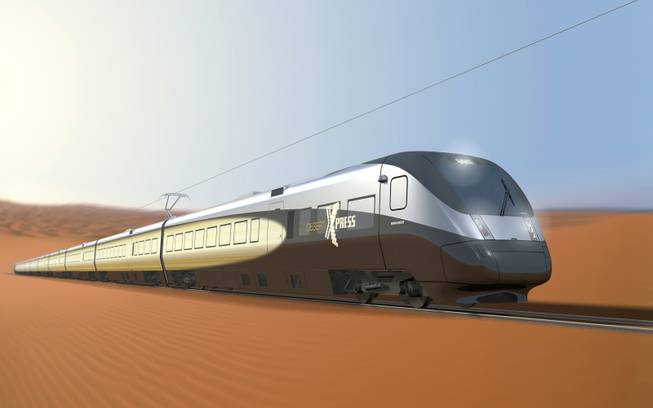
COURTESY PHOTO
A rendering shows a DesertXpress train, which is expected to reach a top speed of about 150 miles per hour and travel between Victorville, Calif., and Las Vegas.
Friday, July 24, 2009 | 3 a.m.
Sun Archives
- Many hands out for stimulus rail money (7-14-2009)
- A boost for DesertXpress (7-3-2009)
- Path clears for federal support of fast train to California (7-2-2009)
- High-speed train plan gets notice in D.C. (6-24-2009)
- Public or private, rail line will need major subsidies from government (6-14-2009)
- Maglev or DesertXPress, this could be your new ride (6-14-2009)
Beyond the Sun
A small Las Vegas company and the 2-year-old Ward 5 Chamber of Commerce are jumping aboard Southern Nevada’s high-speed train debate with a forum on proposals to link Las Vegas and Southern California by rail.
Green Tech Ventures Nevada and the chamber are collaborating on a debate at 6 p.m. July 29 at the Clark County Government Center.
The debate is free, but organizers are asking interested persons to inquire about one of the 200 seats by e-mail at [email protected] by July 27.
The organizers have invited developers of the steel-rail DesertXpress, which would link Las Vegas and Victorville, Calif.; the American Magline Group that would have a maglev between Las Vegas and Anaheim, Calif.; and a third proposal that recently resurfaced.
Thousand Oaks, Calif.-based AVT SolaTrek Corp. is designing a solar-powered maglev hybrid system that would carry cars and passengers on high-speed trains with a shuttle system.
Stan Washington, co-founder of Green Tech Ventures, is a supporter of the SolaTrek system, but he said the purpose of the forum is to educate people about the various technologies under consideration and to allow the public to determine which system makes the most sense for Southern Nevada.
Green Tech Ventures’ goal is to bring management, marketing and development companies focused on environmental solutions together to collaborate on business opportunities.
The company is a member of the Ward 5 chamber, a collection of businesses in one of Las Vegas’ most distressed neighborhoods, which has high jobless and crime rates.
Katie Duncan, president of the chamber, said her organization hopes to boost jobs and green business ventures in the area and sees the high-speed train project as a viable prospect since the terminus for the Southern California-to-Las Vegas route could be in the vicinity of an intermodal transportation hub planned in downtown Las Vegas near Symphony Park.
“With the hub of all of these trains in the area, we’re excited about the potential, but we want some opportunities to trickle down to the people who live here,” Duncan said. “We’re not only looking for the best transportation system, but the developer that provides the best diversity program and the best system for connecting us to the global economy.”
But the system that may be the best to the chamber may not necessarily have the inside track on the route between Southern California and Las Vegas.
DesertXpress appears to be in the lead to develop high-speed rail. The company has nearly completed the environmental impact statements and could begin construction of the $4 billion project next year with completion by 2014.
But it has been dogged by critics who say a train with a Victorville terminus wouldn’t get the ridership necessary to keep it viable.
The American Magline plan, meanwhile, is drafting an environmental-impact statement and is about a year behind DesertXpress. Its critics cite the higher cost than the steel-on-rail system and that a magnetic-levitation system has never been developed in the United States. Maglev boosters note its maintenance costs are lower than steel rail and that a system operating in Shanghai is a huge success.
Sen. Harry Reid, D-Nev., who supported the maglev for years, recently switched to DesertXpress, saying it is further along and has a better chance of success than the maglev. Critics counter that he only switched because political supporter Sig Rogich, who is heading a Republican organization for Reid, is a DesertXpress investor.
The new player in the race isn’t that new.
Frank Randak, president of SolaTrek, has been working to improve his transport system for decades. The solar-powered maglev system linking Los Angeles and Las Vegas is an adaptation of a freeway decluttering proposal that involves riders driving their cars onto a shuttling system that loads a train automatically with a conveyor-belt system while the vehicle is in motion.
Randak’s proposal is different from the American Magline Group’s system in that maglev technology is mounted in the train and not in the guideway.
Randak is developing a design that he would license to conventional transportation groups for construction; he would not finance and build it. He hopes to build a 600-foot test track to show how the system works. He is in negotiations to build that track in Ventura County, Calif., but snags have encouraged him to expand his sites to find a suitable location in Las Vegas, where more people could see it.


Join the Discussion:
Check this out for a full explanation of our conversion to the LiveFyre commenting system and instructions on how to sign up for an account.
Full comments policy